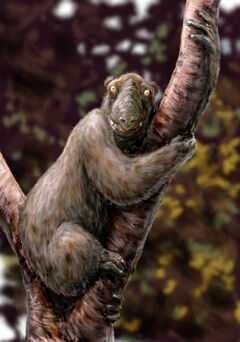
Reconstruction of Megaladapis by Wikipedia user FunkMonk.
Giant lemurs or subfossil lemurs are lemurs which lived in Madagascar until historical times, some of which grew to the size of a chimpanzee. Subfossil remains of lemurs no larger than modern species have also been found; however, it is the giant lemurs which are represented in cryptozoology. Although all the giant lemurs are believed to have been extinct by around the 17th Century, both Malagasy legends and rare sightings hint at their possible late or continued survival.[1][2][3][4]
The most famous genera were Megaladapis, Palaeopropithecus, and the gorilla-sized Archaeoindris, the largest known Malagasy primate. The largest known lemurs on Madagascar today are the indri (Indri indri) and the diademend sifaka (Propithecus diadema).
In cryptozoology[]
Tratratratra[]
- Main article: Tratratratra
One of the most famous, and certainly the longest-known, Malagasy cryptids thought to be a giant lemur is the tratratratra (rendered trétrétrétré in French). It was first described by Admiral Étienne de Flacourt, Governor of Madagascar, in his work Histoire de la Grande Isle de Madagascar (1658), which may also describe elephant birds and giant fossas. He wrote...[5]
| “ | Trétrétrétré is an animal as big as a two-year-old calf, with a round head and a man’s face; the forefeet are like an ape’s, and so are the hindfeet. It has frizzy hair, a short tail and ears like a man’s... One has been seen near the Lipomani lagoon in the neighbourhood of which it lives. It is a very solitary animal, the people of the country are very frightened of it and run from it as it does from them.
|
” |
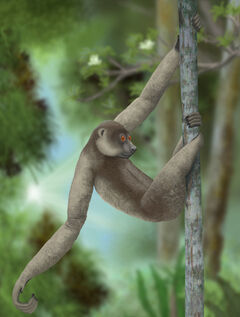
Reconstruction of Palaeopropithecus by Wikipedia user Smokeybjb.
According to Jane Wilson, during the 1930's, a French forester encountered a tratratratra-like lemur unlike any he had seen before, sitting 4' high. It did not have a long muzzle, but had a gorilla-like head and a "face like one of [his] ancestors".[4][6] Arnošt Vašíček has also gathered two modern sightings, one of which occurred as recently as 1991. In 1991, some men from Betsimisaraka tribe who were staying in the foothill forests of the Tsaratanana Mountains were allegedly approached during the night by a tratratratra, which clicked its tongue and studied them cautiously. It had a large body with broad shoulders, and a small pointed head. In the second sighting, a group of girls bathing in the Masora River were frightened by the roaring of a tratratratra, which became trapped in the river's current and stranded on a rock. The girls fled and told their fellows what they had seen, but a rescue party led by a local shaman found the scene empty.[7]
Bernard Heuvelmans identified the tratratratra as a possible surviving chimpanzee-sized Palaeopropithecus ingens, or the smaller Hadropithecus.[3] Karl Shuker notes that while Palaeopropithecus is now known to have had a prominent muzzle, unlike the man-faced tratratratra, Hadropithecus did indeed have a flattened face.[4] According to George Eberhart, however, Hadropithecus and the similar Archaeolemur are probably too small to explain the tratratratra.[1] Dale A. Drinnon regards the gorilla-like Archaeoindris as the origin of the tratratratra,[8] a theory first suggested by Louis Lavauden in 1931.[9] Although Megaladapis is frequently conflated with the tratratratra, this lemur had the most elongated muzzle of all, and is very unlikely to have been described as man-faced.[1][10]
Kidoky[]
- Main article: Kidoky
Another cryptid which may be a giant lemur, and which has allegedly been sighted in relatively recent times, is the kidoky, which is reported from Madagascar's remote southwestern region. According to general accounts gathered by biologist David A. Burney and archaeologist Ramilisonina in 1995, the kidoky resembles a sifaka (Propithecus), but is much larger. A 85-year-old villager named Jean Noelson Pascou claimed to have seen a kidoky in 1952, describing it as a sifaka-like animal "the size of a seven-year-old girl," with a human-like face, dark fur, and two white spots on its forehead and below its mouth. Pascou said that the animal fled on the ground, not into the trees, moving in "a series of bounds," instead of sideways leaps like a sifaka.[10][4] Pascou also imitated the kidoky's call, which was a long single "whoop" similar to that of an indri. Burney and Ramilisonina showed him a picture of this lemur, which is not known from the south, Pascou said it did not resemble the animal he saw.[11]
Burney and Ramilisonina noted that the morphology and lifestyle of the kidoky is highly reminiscent of two kinds of giant lemur, Archaeolemur and Hadropithecus, which displayed some adaptations to a terrestrial lifestyle, and, in the case of Hadropithecus, had flattened faces.[10][4]
Tokandia[]
- Main article: Tokandia
The tokandia is described by Malagasy people as a "huge jumping quadruped, which climbs into the trees, where it lives," and which cries like a man but does not have a man-like face. According to a Malagasy saying, "the tsomgoby goes straight ahead but the tokandia moves in jumps". The tokandia has frequently been connected with Megaladapis, and Bernard Heuvelmans points out that it surely cannot be a coincidence that "this barely credible legend" exists in the one place where a leaping arboreal quadruped did exist.[3]
There are no recorded sightings of the tokandia dating from modern times, and Karl Shuker notes that "even in the least-accessible surviving forests of Madagascar, a koala-shaped lemur the size of a bear would surely be somewhat difficult to overlook".[10]
Habéby[]
- Main article: Habéby
The habéby or fotsiaondré, reported from the Isalo Massif, is compared in size and appearance to a large white sheep: it has a long muzzle, long ears, a white coat dappled with buff or black, and allegedly cloven feet. It is supposed to be nocturnal, with large staring eyes.[1]
Heuvelmans felt that the habéby's features were more reminiscent of a lemur than a sheep: its large staring eyes are characteristic of a lemur, but not an ungulate, no known sheep are nocturnal, and nobody every claimed to see a habéby ram, with horns. He consequently argued that the habéby could be a giant lemur which had become mainly terrestrial due to its weight.[3] Shuker suggests that a very large, terrestrial lemur might have evolved "superficially hoof-like claws to assist its locomotion on the ground".[10] Markus Bühler's suggestion, considered likely by Dale A. Drinnon, is that the habéby is a woolly-furred Megaladapis seen foraging on the ground, and he notes that this lemur's head and skull shape was very reminiscent of that of an ungulate, particularly a sheep. Megaladapis edwardsi was also almost exactly the size of a sheep.[8] Although a Megaladapis's large canines are not sheep-like, Bühler suggests they would be easy to miss in the dark, especially with the animal's mouth closed. Consequently, Bühler considers it "extremely probable that the habéby is based on" Megaladapis.[4]
Mangarsahoc[]
- Main article: Mangarsahoc
Another donkey-like cryptid of Madagascar is the mangarsahoc, which Flacourt, who took it to be a sort of wild ass, described as a very large round-footed beast with long ears which covered its eyes. The Comte de Modave wrote in 1770 that it lived about 10 leagues from Fort Dauphin (now Tôlanaro, in the Anosy Region), and had a "vile reputation," inciting great terror among local people.[4] In 1950, Raymond Decary[12] wrote that this animal was still spoken of in Anosy: both sightings and hoof tracks were reported from Ankaizinana, Bealanana, and Manirenjy.[3]
Heuvelmans felt that the mangarsahoc was more likely a giant lemur than a wild ass (as Karl Shuker puts it, a "very large, terrestrial, pseudo-hoofed lemur"), and Shuker notes that while its reputation of terror is an odd superstition to be attached a horse, it is exactly the kind of belief associated with lemurs such as the aye-aye. Shuker has also aired the suggestion that the mangarsahoc may simply be "a non-existent composite beast, engendered by confusion between Madagascar’s extra-large lemurine cryptids and a very different mystery beast, the tongue-twistingly-named kilopilopitsofy".[4] Another cryptozoological theory listed by Eberhart is that it is an example of a surviving Malagasy hippopotamus, which may also be reported under several other names.[1]
Kalanoro[]
- Main article: Kalanoro
One of Madagascar's most famous cryptids, the "little person" kalanoro, has sometimes been connected with giant lemurs, though this is not widely accepted in cryptozoology. It is described as a 2' to 3' high man covered in hair, with long head-hair, hooked nails, and only three toes. It has many characteristics in common with fairies and even merbeings, as it is sometimes described as aquatic.[1]
G. Herbert Smith, writing in the Antananarivo Annual (1886), thought that eyewitness descriptions of kalanoros sneaking into villages sounded "suspiciously like one of the larger sorts of lemur", and the French palaeontologist Charles Lamberton suggested that the kalanoro could be based on folk memories of the man-faced Hadropithecus.[10] Archaeolemur has also been proposed as an explanation.[1]
However, Karl Shuker writes that he is not convinced by a lemur identity, as the kalanoro is described as extremely humanoid, tailless, and bipedal. Instead, Shuker suggests that if the kalanoro is not simply a little person-type myth, it may be "a primitive form of human," as it is reminiscent of the orang-pendek. He also writes that, if the kalanoro was ever real, it is likely to be extinct, as no sightings have been recorded for a long time.[10] However, it may still be recorded from elsewhere on Madagascar under the name kotoko.[4]
Kisuala[]
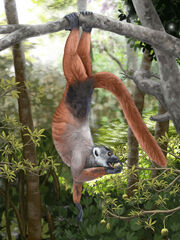
Reconstruction of Pachylemur by Wikipedia user Smokeybjb.
- Main article: Kisuala
In 2018, Forrest Galante gathered reports of a "new" giant cryptid lemur from Madagascar, the kisuala, which was described as giant and red-furred. Its description prompted speculation that it may be a surviving giant ruffed lemur (Pachylemur).[13][14] However, after seeing large red ruffed lemurs (Varecia rubra) in the wild, Galante concluded that the kisuala could easily be a misidentified, exaggerated lemur of that species.[15]
Giant aye-aye[]
- Main article: Giant aye-aye
The subfossil lemurs of Madagascar include a giant variety of aye-aye, Daubentonia robusta, which was somewhere between two and five times the size of a normal aye-aye (Daubentonia robusta). Subfossil evidence shows that it was contemporaneous with, and hunted by, humans.[1] Although no Malagasy legends or sightings of such an animal have been recorded, in 1930 a government official named Hourcq discovered an "exceptionally large aye-aye skin" in a house near Andranomavo, in Madagascar's Soalala District.[16] The skin's size has nurtured the theory that it may have been from a late-surviving giant aye-aye.[1][17][18]
Other cryptids[]
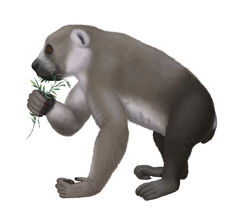
Reconstruction of Archaeoindris by Wikipedia user Smokeybjb.
Primatologist Allison Jolly collected reports of two unknown lemurs in Madagascar. The smaller, sometimes connected with Hadropithecus,[8] was the size of a guenon (Cercopithecus), with reddish-brown fur and a flat face. The larger was the size of a chimpanzee, with black-and-white fur and a similarly flattened face.[19][20] According to Dale A. Drinnon, certain older natural history books refer to a sort of "giant indri" which was stocky and colourful, and could grow to be the size of a human being: Drinnon suggests this is a relative of Palaeopropithecus. Another oddity noted by Drinnon is the fact that the Malagasy language contains a word for "bear," bera or beru, despite that animal not existing in Madagascar, leading him to suggest the term might refer to Megaladapis. Drinnon also writes that more modern reports of "Bigfoot" and "apes" in Madagascar may refer to the gorilla-like Archaeoindris.[8]
Supposed captive giant lemurs[]
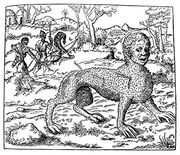
Illustration of the thanacth from André Thevet's Cosmographie Universelle (1575)
One cryptid which was not definitely from Madagascar, the thanacth, is sometimes thought of as a giant lemur, possibly an example of the tratratratra. This animal was captured in the 16th Century by a party of Bengali Indians, and shown to André Thevet at his base in the Red Sea.[8] Thevet described it as a four-footed beast the size and shape of a tiger, with tawny body fur and frizzled, blackish head-hair. Its hands and face were like a man's, with a snub nose, and it had no tail, but its hind feet were like a tiger's.[1]
The thanacth's country of origin is unknown, but it is sometimes thought to have been Madagascar. According to Karl Shuker, the thanacth "appears to have been the same or at least a very similar unidentified species" to the tratratratra,[10] and Heuvelmans also regarded it as a displaced giant lemur.[8] An alternative explanation listed by George Eberhart is that the thanacth was a known species of lemur, such as the indri, or even an Indian loris, which however do not grow so large.[1]
Current status[]
Writing in 1955, Bernard Heuvelmans felt that scientists had likely missed their opportunity to find living giant lemurs, regarding most of the Malagasy stories as folk memory. However, citing the example of the large nocturnal okapi, he also wrote that "as there are still some 8,000,000 or 9,000,000 acres of virgin forest [in Madagascar], it would be rash to assert categorically that not a single giant lemur survives," and pointed out that lemurs, "nimble, intelligent creatures which live in forests and are nocturnal in habits would have a much better chance than a horse or ass of eluding our searches."[3]
Karl Shuker writes that, although "unlikely, it is not impossible that a very small, relict population of at least one species of giant lemur does still persist in Madagascar, highly elusive, nocturnal, and actively avoiding humans whenever possible" and "it is not entirely beyond hope that small numbers of one or more species of giant lemur may still linger in the most inaccessible, least visited regions of this extraordinary island."[10]
See also[]
Many other examples of supposedly recently-extinct Malagasy megafauna are sometimes theorised to still exist, including the giant fossa, giant Malagasy tortoise, Malagasy hippopotamus, Malagasy crocodile, and elephant bird. The Malagasy crowned eagle is also sometimes thought to be the roc of Arabic folklore. Other cryptid lemurs include the miniscule malagnira of Tsingy de Bemaraha, and the black indri.
Notes and references[]
- ↑ 1.00 1.01 1.02 1.03 1.04 1.05 1.06 1.07 1.08 1.09 1.10 Eberhart, George M. (2002) Mysterious Creatures: A Guide to Cryptozoology, ABC-CLIO, Inc., ISBN 1576072835
- ↑ Shuker, Karl P. N. (2016) Still In Search Of Prehistoric Survivors: The Creatures That Time Forgot?, Coachwhip Publications, ISBN 978-1616463908
- ↑ 3.0 3.1 3.2 3.3 3.4 3.5 Heuvelmans, Bernard (1955) On the Track of Unknown Animals, Routledge, ISBN 978-1138977525
- ↑ 4.0 4.1 4.2 4.3 4.4 4.5 4.6 4.7 4.8 Shuker, Karl P. N. (2013) Mirabilis: A Carnival of Cryptozoology and Unnatural History, Anomalist Books, ISBN 978-1-938398-05-6
- ↑ Flacourt, Étienne de (1658) Histoire de la Grande Isle de Madagascar
- ↑ Wilson, Jane (1990) Lemurs of the Lost World
- ↑ Vašíček, Arnošt (2005) Planeta Záhad: Tajemná Minulost, Mystery Film, ISBN 9788023954845
- ↑ 8.0 8.1 8.2 8.3 8.4 8.5 Drinnon, Dale A. Frontiers of Zoology: Persisting Giant Lemurs of Madagascar frontiersofzoology.blogspot.com [Accessed 29 April 2020]
- ↑ Lavauden, Louis "Animaux Disparus et Légendaires de Madagascar," Revue Scientifique 69 (1931)
- ↑ 10.0 10.1 10.2 10.3 10.4 10.5 10.6 10.7 10.8 Shuker, Karl P.N. ShukerNature: MADAGASCAR'S ELUSIVE MEGA-LEMURS AND MINI-MEN karlshuker.blogspot.com [Accessed 29 April 2020]
- ↑ Burney, David A. & Ramilisonina "The Kilopilopitsofy, Kidoky, and Bokyboky: Accounts of Strange Animals from Belo-sur-Mer, Madagascar, and the Megafaunal 'Extinction Window,'" American Anthropologist 100 (1998)
- ↑ Decary, Raymond (1950) La Faune Malgache, Son Role dans les Croyances et les Usages Indigenes
- ↑ Shuker, Karl "Missing in Madagascar?," Fortean Times 379 (May 2019)
- ↑ Shuker, Karl P.N. ShukerNature: INTRODUCING THE KISUALA - MISSING IN MADAGASCAR? karlshuker.blogspot.com [Accessed 29 April 2020]
- ↑ "Pachylemur: The Madagascar Giant". Extinct or Alive: Series 1, Episode 2.
- ↑ Hill, W. C. Osman (1953) Primates: Comparative Anatomy and Taxonomy, Vol. 1: Strepsirhini
- ↑ Shuker, Karl P. N. "A Supplement to Dr Bernard Heuvelmans' Checklist of Cryptozoological Animals," Fortean Studies, Vol. 5 (1998)
- ↑ Shuker, Karl P. N. (2003) The Beasts That Hide From Man: Seeking the World's Last Undiscovered Animals, Paraview Press, ISBN 1-931044-64-3
- ↑ Drinnon, Dale A. (2009) "Amended Cryptozoological Checklist"
- ↑ Jolly, Allison (1980) A World Like Our Own: Man and Nature in Madagascar, Yale University Press, ISBN 978-0300024784
